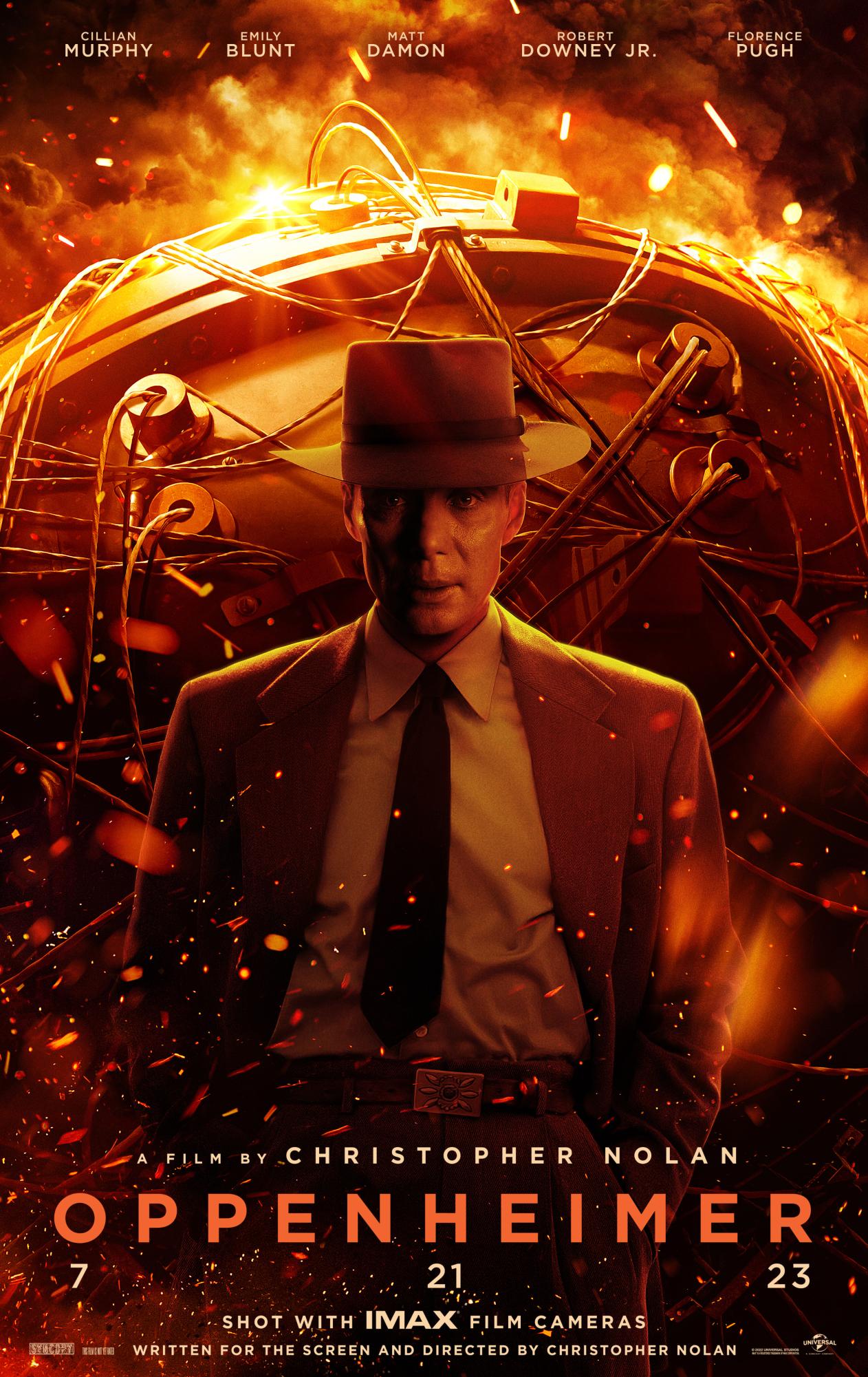In December of 1938, Germany stunned the global scientific community with the discovery of nuclear fission. Almost a year later, World War II began.
Fearing the threat of a bomb in Nazi hands, sitting U.S. president Franklin Delano Roosevelt formed the Advisory Committee on Uranium to determine the possibility of constructing a bomb.
Following the U.S.’s formal entry into the war, the Committee concluded that a bomb might be constructed. Thus came the Manhattan Project, headed by theoretical physicist J. Robert Oppenheimer.
The 2023 blockbuster movie Oppenheimer follows Oppenheimer’s life from the time he first established a School of Quantum Physics at Berkeley to heading the top-secret Manhattan Project. Directed by Christopher Nolan, the film has surpassed $900 million at worldwide box office ticket sales.
Aside from its renowned cast, visual effects, and captivating music, the film highlights the ethical and political consequences of U.S. possession of the atomic bomb and illustrates the moral and psychological impact upon Oppenheimer himself.
Elements of Cinematography
Nolan effectively uses a variety of elements to help the audience understand the quantum physics used to construct the atomic bomb, which is woven through the story of Oppenheimer’s life.
For instance, the film uses a combination of muted and cool undertones to draw attention to the 20th century setting. In fact, two types of filters are juxtaposed to help the audience understand two different points of view about Oppenheimer’s life, yet each filter takes on a variety of meanings.
The black and white filter represented the viewpoint of Louis Strauss, the Atomic Energy Commission chairman, who was critical and disdainful of Oppenheimer. It may also capture the more accurate moments in Oppenheimer’s lifetime. The dramatic cool filter on the other hand was used to portray Oppenheimer’s unique interior world.
Oppenheimer’s thinking is ‘stimulated’ when his teacher at Cambridge encourages him to “hear the music.” This serves as a subtle transition into Oppenheimer’s point of view. Nolan uses a montage of images to help the viewers visualize Oppenheimer’s “hidden universe” as he explores quantum physics theory. These visual aids include swirling specs of stardust, vibrations of atoms in an uncontrolled chain reaction, and a slow-motion nuclear explosion. He then explains Oppenheimer’s visions in later scenes throughout the movie.
The music, composed by Ludwig Göransson, accompanies these snippets of Oppenheimer’s thoughts, and helps create a mysterious and thought-provoking mood that evokes a sense of danger, euphoria, and mania all at the same time.
For example, when Oppenheimer first meets Kitty (his future wife), he begins explaining the theories he has been teaching at Berkeley. His simple yet sophisticated explanation can be understood by the audience as a visual aid had already been presented beforehand.
“What happens to stars when they die?” he asks. “If they do, they cool then collapse. In fact, the bigger the star, the more violent its demise. The gravity gets so concentrated, it swallows everything…even light.”
Navigating the Ethics of Science and War
Nolan’s film is largely adapted from the biography American Prometheus: The Triumph and Tragedy of J. Robert Oppenheimer by Kai Bird and Martin J. Sherwin. Like the book, the filmmakers compare Oppenheimer to Prometheus, a titan from Greek mythology who stole fire from the gods and brought it back to mankind. In the film, this comparison is first introduced in the opening caption.
Fire allowed humans to forge weapons and wage war and stimulated rapid advancement in human civilization. After learning what had happened, Zeus imposed a heavy punishment. Prometheus was chained to a cliff for eternity. Every day, a vulture would tear out his liver which would regrow at night only to be shredded again the next day.
Although he experienced everlasting suffering, he never regretted his actions. Prometheus is ultimately remembered for the advancement, knowledge and power he brought to humans and is a symbol of humans’ ability to control the forces of nature.
The gift of fire is symbolic of technological and scientific innovation, and the growth of civilization; yet it also represents war and destruction. Oppenheimer’s atomic bomb represented the same dualities. Much as humans were ever closer to wielding the power of the Gods with the possession of fire, Oppenheimer’s nuclear tests also allowed humans to wield a divine power–the power of the sun. This is why Oppenheimer named the atomic bomb test ‘Trinity’.
Not only does the film reference the myth of Prometheus in the opening caption, but it also directly named Oppenheimer to be Prometheus. When Oppenheimer asks Neils Bohr, a scientist whom he respected, to join the Manhattan Project, Bohr refuses, rather saying that it was necessary to help prepare the world with the possession of the bomb.
“You are an American Prometheus, a man who gave them the power to destroy themselves. And they’ll respect that. And your work really begins,” Bohr said.
Like Prometheus, who essentially paved the way for humans to engage in war and violence, Oppenheimer’s creation of the atomic bomb sparked the arms race and the ideology of MAD (mutually assured destruction) during the Cold War, both of which defined the coming decades. However, many have argued whether or not Oppenheimer’s choices–just as Prometheus’s–were justified.
This is best seen with Prometheus’s punishment. The liver was considered to be the seat of emotion in Greek myths and thus, the endless tearing of Prometheus’s liver symbolized the ethical debates surrounding the use of the atomic bomb.
In the film, Oppenheimer joined the Manhattan project because he believed the bomb would be safer in American hands.
He confides in his colleague and friend Izzy (Isador Isaac Rabi).
“I don’t know if we can be trusted with such a weapon,” he says. “But I know the Nazis can’t. We have no choice.”
Additionally, Oppenheimer directly justifies the use of the atomic bomb during a private meeting of scientists that contemplated the ethics of using the atomic bomb.
“We’re theorists, yes? We imagine a future and our imaginings horrify us,” Oppenheimer said. “[The world] won’t fear it until they understand it. And they won’t understand it until they’ve used it. When the world learns the terrible secret of Los Alamos, our work here will ensure a peace mankind has never seen. A peace based on the kind of international cooperation that Roosevelt always envisioned.”
However, the movie also confronts the horror of the scientists’ creation. Just as Prometheus was perpetually tormented by the daily devouring of his liver, Oppenheimer too forever struggled to live with the consequences of his creation. He learned that between 13,000 and 215,000 people died from not only acute exposure to the blasts, but also the long-term side effects of radiation in Nagasaki and Hiroshima combined.
This conflict is best illustrated in one of the most famous scenes of Oppenheimer delivering his ‘success’ speech for the detonation of the atomic bomb. As he walks to the podium, the crowd chants “Oppy! Oppy! Oppy!” and then there’s a rumble.
As opposed to the previous ‘rumblings’ throughout the film which have served more as background noise and symbolized progress, the series of stomps and claps is deafening and foreboding. Following Oppenheimer’s remarks about Hiroshima and Nagasaki, the room explodes into more applause. Then, the room starts to shake and the audience’s clamor ceases.
A child’s scream pierces through the crowd. The viewer is suddenly pulled into the turmoil in Oppenheimer’s mind. He finds himself standing in the center of Hiroshima as Little Boy detonates. There’s a flash of light that pulls him back to the present.
Cheerful faces in the crowd immediately turn to disgust, and more screaming envelopes his ears. People in the audience start to burn and disintegrate to ash. As Oppenheimer turns to leave, he finds his foot stuck in an incinerated human corpse.
Finally emerging outside, he then witnesses a colleague vomiting. In this scene, Oppenheimer is imagining the horrific experience the Japanese people will succumb to, as the vomiting alluded to what Oppenheimer knew awaited the survivors: radiation poisoning, fatigue, disorientation, internal bleeding and lastly, death.
This is what led Oppenheimer to staunchly oppose the U.S. plan to develop a hydrogen bomb.
Instead, Oppenheimer hoped for international regulation of the weapon; yet scientists had no authority about how the bomb would be used.
“The fact that we built this bomb does not give us any more right or responsibility to decide how it’s used than anyone else,” said Oppenheimer.
After WWII, Oppenheimer joined the General Advisory Committee of the Atomic Energy Commission, which stressed international cooperation and regulation of atomic weapons; yet Lewis Strauss and President Truman eventually ignored Oppenheimer’s concerns about an arms race, and decided to continue the program to upgrade their bomb for protection against the Soviets.
However, amongst national greed and a focus competition in the arms race, there have been 32 nuclear accidents (since 1950) and nuclear power plant catastrophes such as Chernobyl and Fukushima.
Historical Liberties: Truth v. Tale
One of the major controversies surrounding Nolan’s film is that it covers up the truth about Los Alamos. In the film, Oppenheimer suggests building one of the facilities for the Manhattan project in Los Alamos, New Mexico because he claimed that relatively few people were living there; however, in reality, the film underscores the thousands of U.S. citizens who died from the atomic bomb test.
To build the lab, the government forced countless families to abandon their land. In the Pajarito Plateau, the US Army gave 32 Hispanic families two days to leave their homes, and some were forcibly removed at gunpoint. Families were given little to no compensation as their homes were bulldozed and their livestock were shot or let loose.
Additionally 500,000 people were living within a 150 mile radius of the test site. Just 12 miles away from the test site was the Tularosa Basin, home to a rural population that tended to farms and gardens, raised livestock, and drew water from cisterns and holding ponds. Due to the secretive nature of the project, residents in the surrounding areas were not warned or even evacuated before or after the test.
According to the Associated Press, the government initially covered up the affair, insisting that the rumble and bright light had been caused by an explosion at a munitions dump, which could be seen 160 miles away. Only when the US dropped the atomic bombs on Japan a couple of weeks later did the New Mexicans understand what they had witnessed.
As a result, residents as well as younger generations had to deal with the consequences of the blast: cancer and radiation poisoning.
“[The US Government] poisoned its own people, many of whom are still waiting for recognition and justice,” said Lilly Adams, a senior outreach coordinator with the Union of Concerned Scientists.
Adams, along with many of the New Mexico residents, had hoped for Nolan’s film to raise awareness about the true story behind the construction of the Los Alamos lab; however, the movie, like the government, covered up the story.
Although Nolan’s film contains some inaccuracies, the movie is most acclaimed for shedding light on the ethics debate surrounding the bomb as well as the consequential events that followed its construction.
As a result, Nolan leaves the audience with a grim ending. While conversing with Einstein, Oppenheimer shares his fear that the detonation of the bomb might destroy the entire world. As he stares off into the distance, the scene cuts to another montage of images showing US arsenal numbers, missiles being launched and their destruction and finally a view of Earth’s atmosphere incinerating.
In this way, the filmmakers highlight the daunting reality of what the world has become fixated on: exponential military spending, nuclear programs and innovations in weaponry.














